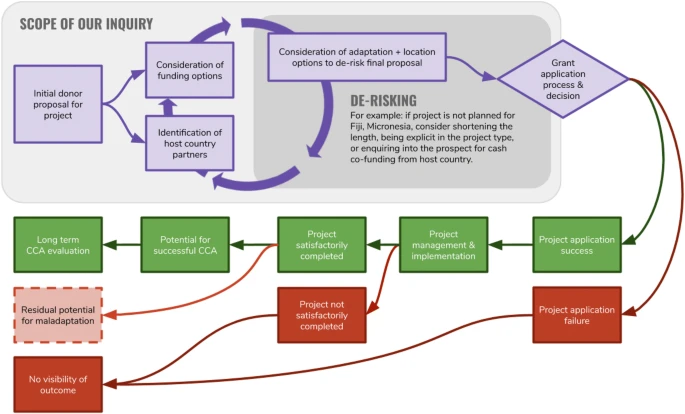
Village communities across the Pacific, such as the one above (Port Resolution), are the focus of grants programmes set up to improve their resilience and adaptive capacity to climate change.
Over recent decades, substantial funding from a variety of sources has been directed towards climate change adaptation projects in Pacific Island countries. There remains, however, considerable uncertainty about which factors influence adaptation project completion, as a pre-cursor to effective adaptation. In this study, we empirically establish the links between project attributes(duration, funding, cash co-financing, in-kind contributions, location, and adaptation approach) and whether a project is likely to complete or be terminated.
Approach
We examine this issue by using an econometric technique, to build a logistic regression model. This technique can help identify the influence various attributes of a model have on the final result, in this instance, the successful completion of a climate change adaptation project. It can also help identify the interactions between different attributes.
Using this model we can predict the probability of completion for small-scale climate change adaptation projects. We build this model using a dataset of 190 projects in the South Pacific (with end dates ranging from November 1995 to May 2016) that were financed through the Global Environment Facility Small Grants Programme (GEF-SGPGEF-SGP Acronym for Global Environment Facility Small Grants Programme.).
Though the ultimate goal should be to objectively, comprehensively, and consistently evaluate the medium- to long-term effectiveness of adaptation actions, without the systematic reporting highlighted above, project completion status can be considered, at least, the first step data point for reducing risk of failure of adaptation outcomes, particularly as not all funded projects are completed as planned.
Method
This study analysed 190 completed projects funded under the GEF-SGP across 15 PICsPICs Pacific Island Countries (plural).: Cook Islands, Federated States of Micronesia (FSM), Fiji, Kiribati, Marshall Islands, Nauru, Niue, Palau, Papua New Guinea (PNGPNG Papua New Guinea), Samoa, Solomon Islands, Tokelau, Tonga, Tuvalu, and Vanuatu. The projects are small scale and have limited budgets (maximum funding is US$50,000, mean funding is US$25,000 per project, affording little opportunity for sophisticated project management tracking.
In this context, we considered it useful for project proponents and project funders to know whether proposed projects carry higher risks of failure to complete. If prior information regarding the risk of completion failure is available, proponents can design projects to better mitigate those risks, and where appropriate, funders can focus their remaining budget towards supporting actions that mitigate these risks and thus increase the chances of project completion as a first step towards delivering the desired adaption outcomes.
We limited our study to GEF-SGP projects as consistent (and therefore comparable) project-specific information is available to the public through the programme’s website.
Findings
All other things equal, projects in Fiji and Micronesia have significantly higher probability of completion than projects in PNG (the baseline country category). Projects that receive higher co-financing in cash or in-kind have higher probability of completion, as do projects that are explicitly targeted towards climate change adaptation.
Projects that receive higher grant funding, and longer projects, have a lower probability of completion, all else equal. Projects that combine ecosystem-based adaptation and hard-engineered structures in their approach have significantly lower probability of completion compared to projects which use ecosystem-based adaptation alone, all else equal.
With regard to CCACCA Climate change adaptation - actions or policies taken to adapt communities, infrastructure, nature, and the economy to mitigate risks from climate change and take advantages of opportunities. categories, if an adaptation project is explicitly designed and targeted towards CCA, this substantially increases the probability of completion. A potential explanation could be that a CCA-targeted project may provide a clearer starting point from which to engage local communities and other relevant stakeholders; for example, the literature around development and project implementation stresses the importance of clear, consistent communication with implementing communities.
Implications
The figure below shows where our results and model can help inform project application development, by mitigating risk of project non-completion, on the assumption that in order for a CCA project to be ultimately successful, it must first be completed, though emphasising again that completion does not guarantee successful adaptation. Our inquiry can also potentially assist grant application assessors in their liaison function with project proponents.

Figure above: Locating the scope of our enquiry in decision making over funding climate change adaptation projects.
What this means for policy
Whilst our results show that a singular focus on either hard-engineered, ecosystem-based, or human capital development likely assists project completion for smaller projects, many CCA challenges are likely to demand a combination of some or all of these elements and most likely much higher levels of finance to be effective in supporting resilient and adaptable communities in the long term. Therefore, our findings should not be used to justify discouragement of funding support for more complex, multidisciplinary approaches to adaptation within the realm of the GEF-SGP.
Rather, our results suggest that in situations where complex, multidisciplinary projects are determined to be required by a project proponent, funders should seek to mitigate against the risk of potential project failure by paying attention to those other factors that appear to enhance completion, such as promoting co-financing cash from other donors and project partners. Alternatively, where circumstances are warranted, funders should be prepared to tolerate higher levels of risk of failure surrounding their project funding decisions, which invariably goes against the grain of business case development, which generally promotes projects with the lowest risks of failure. As the GEF promotes itself as a risk taker and an innovator, understanding how to decrease known risks of non-completion, at the margins, is vital.
Similarly, it is important not to misinterpret our findings in ways that could undermine continued investment in CCA projects across the whole South Pacific region. For example, whilst our results reveal the relatively lower probability of project completion in Samoa or PNG, this should not be interpreted as a recommendation to avoid pursuing CCA projects in these countries. In such circumstances, our results could be used to inform project funders of how the probability of completion could be increased through appropriate modifications to project design. For example, for Samoa, adding $5000 of co-financing cash to the median GEF-SGP project grant ($19,442) increases the probability of completion from 66 to 77%, whilst adopting an explicit, rather than implied, CCA focus increases the probability of completion from 71 to 90%.
Acknowledgements
This research was supported by a grant from a charitable organisation which neither seeks nor permits publicity for its efforts. The organisation played no role in any aspect of the research reported here. We are also grateful for the assistance of Chantal Saint-Ange in producing the map.
About the lead author:
Dr. Syezlin Hasan
Environmental economist and expert in econometrics modelling and stated preference research design.
Assoc. Prof. Jim Smart
Co-lead – Micro-economics, benefit-cost analysis, non-market valuation
Request a copy of the article
If the download article link below doesn’t work, or leads to a page that requests payment, please click the link to the author profile above and request a copy directly and they will be happy to assist. Not all reviewed journal articles are published as ‘open access’, which are free to download.

